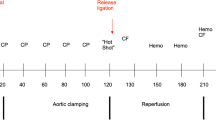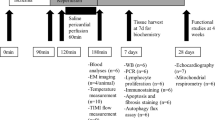Summary
The effect of cold and warm intermittent antegrade blood cardioplegia, on the intracellular concentration of taurine in the ischaemic/ reperfused heart of patients undergoing aortic valve surgery, was investigated. Intracellular taurine was measured in ventricular biopsies taken before institution of cardiopulmonary bypass, at the end of 30 min of ischaemic arrest and 20 min after reperfusion. There was no significant change in the intracellular concentration of taurine in ventricular biopsies taken after the period of myocardial ischaemia in the two groups of patients (from 10.1 ± 1.0 to 9.6 ±0.9μmol/g wet weight for cold and from 9.3 ± 1.3 to 10.0 ± 1.3μmol/g wet weight for warm cardioplegia, respectively). Upon reperfusion however, there was a fall in taurine in both groups but was only significant (P → 0.05) in the group receiving cold blood cardioplegia (6.9 ± 0.8μmol/g wet weight after cold blood cardioplegia versus 8.0± 0.8μmol/g wet weight following warm blood cardioplegia). Like taurine, there were no significant changes in the intracellular concentration of ATP after ischaemia in the two groups of patients (from 3.2 ± 0.32 to 2.95 ± 0.43μmol/g wet weight for cold and from 2.75 ± 0.17 to 2.62 ± 0.21μmol/g wet weight for warm cardioplegia, respectively). However upon reperfusion there was a significant fall in ATP in both groups with the extent of the fall being less in the group receiving warm cardioplegia (1.79 ± 0.19μmol/g wet weight for cold and 1.98 ± 0.27μmol/g wet weight for warm cardioplegia, respectively). This work shows that reperfusion following ischaemic arrest with warm cardioplegia reduces the fall in tissue taurine seen after arrest with cold cardioplegia. Accumulation of intracellular sodium provoked by hypothermia and a fall in ATP, may be responsible for the fall in taurine by way of activating the sodium/taurine symport to efflux taurine.
Similar content being viewed by others
References
Bhatnagar SK, Welty JD, A1-Yusuf AR (1990) Significance of blood taurine levels in patients with first time acute ischemic cardiac pain. Int J Cardiol 27: 361–366
Chapman RA, Suleiman M-S, Rodrigo GC, Minezaki KK, Chatamra KR, Little CR, Mistry DK (1993) In: Noble D, Earm YE (eds) Cardiac ion channels and effects of taurine on heart. Kluwer Press, Boston, pp 73–91
Chapman RA, Suleiman MS, Earm YE (1993) Taurine and the heart. Cardiovasc Res 27: 358–363
Cohen SA, Meys M, Tarvin TL (1989) Pico-Tag advanced methods manual. Printed by the Millipore Corporation, Bedford, MA, USA
Cooper MW, Lombardini JB (1981) Elevated blood levels after myocardial infarction or cardiovascular surgery. Is there any significance? Adv Exp Med Biol 139: 191–205
Diederichs F, Wittenberg H, Sommerfeld U (1990) Myocardial cell damage and breakdown of cation homeostasis during conditions of ischaemia and reperfusion, the oxygen paradox and reduced extracellular calcium. J Clin Chem Clin Biochem 28: 139–148
Huxtable R, Bressler R (1974) Taurine concentrations in congestive heart failure. Science 184: 1187–1188
Huxtable RJ (1992) Physiological actions of taurine. Physiol Rev 72: 101–163
Kramer JH, Chovan JP, Schaffer SW (1981) Effect of taurine on calcium paradox and ischaemic heart failure. Am J Physiol 240: H231-H246
Lombardini JB, Crass MF (1981) Taurine and myocardial ischaemia. In: Schaffer S, Baskin S, Kocsis J (eds) The effects of taurine on excitable tissue. Spectrum, New York, pp 419–435
Lombardini JB, Bricker DL (1981) Effects of cardiovascular surgery on blood concentration of taurine and amino acids. Proc Soc Exp Biol Med 167: 498–505
Lowry OH, Rosebrough NJ, Farr AL, Randall RJ (1951) Protein measurement with the Folin phenol reagent. J Biol Chem 193: 265–275
Peterson MB, Mead RJ, Welty JD (1973) Free amino acids in congestive heart failure. J Mol Cell Cardiol 5: 139–147
Pasantes-Morales H, Schousboe A (1997) Role of taurine in osmoregulation in brain cells: mechanisms and functional implications. Amino Acids 12: 281–292
Punna S, Ballard C, Hamaguchi T, Azuma J, Schaffer S (1994) Effect of taurine and methionine on sarcoplasmic reticular Ca2+ transport and phospholipid methyltransferase activity. J Cardiovasc Pharmacol 24: 286–292
Schaffer SW, Allo S, Mozaffari M (1987) Potentiation of myocardial ischaemic injury by drug-induced taurine depletion. In: Huxtable RJ, Franconi F, Giotti A (eds) The biology of taurine. Plenum Press, New York London, pp 151–158
Spielman H, Jacob-Miller V, Schulz P (1981) Simple assay of 0.1-I.Opmol of ATP, ADP and AMP in single somatic cells using purified luciferin luciferase. Anal Biochem 113: 172–176
Suleiman M-S (1994) New concepts in the cardioprotective action of taurine and magnesium during the calcium paradox and ischaemia of the heart. Magnesium Research 7: 295–123
Suleiman M-S, Chapman RA (1990) The effect of temperature on the rise in intracellular odium during calcium depletion in ferret ventricular muscle and the mechanisms of the alleviation of the calcium paradox by hypothermia. Circ Res 67: 1238–1246
Suleiman M-S, Rodrigo GC, Chapman RA (1992) Interdependence of intracellular taurine and sodium in guinea pig heart. Cardiovasc Res 26: 897–905
Suleiman M-S, Fernando C, Dihmis W, Hutter J, Chapman RA (1993) A loss of taurine and other amino acids from ventricles of patients undergoing bypass surgery. Br Heart J 69: 241–245
Suleiman M-S, Moffatt A, Dihmis WC, Caputo M, Angelini GD, Hutter JA, Bryan AJ (1997) Effect of ischaemia and reperfusion on the intracellular concentration of taurine and glutamine in the hearts of patients undergoing coronary artery surgery. Biochim Biophys Acta 1324: 223–231
Tani M (1990) Mechanisms of Ca2+ overload in reperfused ischemic myocardium. Annu Rev Physiol 52: 543–559]
Author information
Authors and Affiliations
Rights and permissions
About this article
Cite this article
Ascione, R., Gomes, W.J., Angelini, G.D. et al. Warm blood cardioplegia reduces the fall in the intracellular concentration of taurine in the ischaemic/reperfused heart of patients undergoing aortic valve surgery. Amino Acids 15, 339–350 (1998). https://doi.org/10.1007/BF01320898
Received:
Accepted:
Issue Date:
DOI: https://doi.org/10.1007/BF01320898




